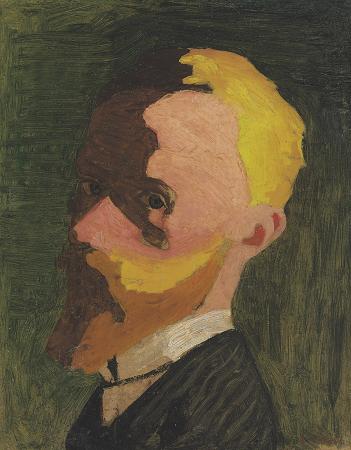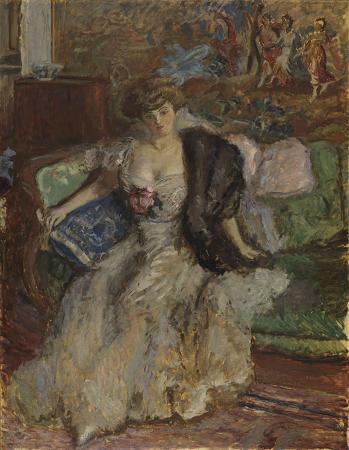Pierre Bonnard (1867 - 1947). Pierre Bonnard was a French painter, illustrator, and printmaker, known especially for the stylized decorative qualities of his paintings and his bold use of color. He was a founding member of the Post-Impressionist group of avant-garde painters Les Nabis, and his early work was strongly influenced by the work of Paul Gauguin, and the prints of Hokusai and other Japanese artists. He was a leading figure in the transition from impressionism to modernism. He painted landscapes, urban scenes, portraits and intimate domestic scenes, where the backgrounds, colors and painting style usually took precedence over the subject. Pierre Bonnard was born in Fontenay-aux-Roses, Hauts-de-Seine on 3 October 1867. His mother, Élisabeth Mertzdorff, was from Alsace. His father, Eugène Bonnard, was from the Dauphiné, and was a senior official in the French Ministry of War. He had a brother, Charles, and a sister, Andrée, who in 1890 married the composer Claude Terrasse. He received his education in the Lycée Louis-le-Grand and Lycée Charlemagne in Vanves. He showed a talent for drawing and water colors, as well as caricatures. He painted frequently in the gardens of his parent's country home at Grand-Lemps near the Cote Saint-André in the Dauphiné. He also showed a strong interest in literature. He received his baccalaureate in the classics, and, to satisfy his father, between 1886-87 earned his license in law, and began practicing as a lawyer beginning in 1888. While he was studying law, he also attended art classes at the Académie Julian in Paris. At the Académie Julien he met his future friends and fellow artists, Paul Sérusier, Maurice Denis, Gabriel Ibels and Paul Ranson. In 1888, Bonnard was accepted by the École des Beaux-Arts, where he met Edouard Vuillard and Ker Xavier Roussel. He also sold his first commercial work of art, a design for poster for France-Champagne, which helped him convince his family that he could make a living as an artist. He set up his first studio at on rue Lechapelais and began his career as an artist. From 1893 until her death, Bonnard lived with Marthe de Méligny, and she was the model for many of his paintings, including many nudes. Her birth name was Maria Boursin, but she had changed it before she met Bonnard. They married in 1925. In the years before their marriage, Bonnard had love affairs with two other women, who also served as models for some of his paintings, Renée Monchaty and Lucienne Dupuy de Frenelle, the wife of a doctor; it has been suggested that Bonnard may have been the father of Lucienne's second son. Renée Monchaty committed suicide shortly after Bonnard and de Méligny married. Bonnard received pressure from a different direction to continue painting. While he had received his license to practice law in 1888, he failed in the examination for entering the official registry of lawyers. Art was his only option. After the summer holidays, he joined with his friends from the Academy Julien to form Les Nabis, an informal group of artists with different styles and philosophies but common artistic ambitions. At the time, Bonnard, as he later wrote, was entirely unaware of the impressionist painters, or of Gauguin and other new painters. His friend Paul Sérusier showed him a painting on a wooden cigar box he made after visiting Paul Gauguin at Pont-Aven, using, like Gauguin, patches of pure color. In 1890 Denis, at age twenty, formalized the doctrine: a painting was simply a surface plane covered with colors assembled in a certain order. Some of the Nabis had highly religious, philosophical or mystical approaches to their paintings, but Bonnard remained more cheerful and un-ideological. The painter-writer Aurelien Lugné-Poe, who shared a studio at 28 rue Pigalle with Bonnard and Vuillard, wrote later, Pierre Bonnard was the humorist among us; his nonchalant gaiety, and humor expressed in his productions, of which the decorative spirit always preserved a sort of satire, from which he later departed. In 1891, he met Toulouse-Lautrec and in December 1891 showed his work at the annual exhibition of the Société des Artistes Indépendants. In the same year Bonnard also began an association with La Revue Blanche, for which he and Édouard Vuillard designed frontispiece In March 1891, his work was displayed with the work of the other Nabis at the Le Barc de Boutteville. The style of Japanese graphic arts became an important influence on Bonnard. In 1893 A major exposition of works of Utamaro and Hiroshige was held at the Durand-Rouel Gallery, and the Japanese influence, particularly the use of multiple points of view, and the use of bold geometric patterns in clothing, such as checkered blouses, began to appear in his work.
more...













